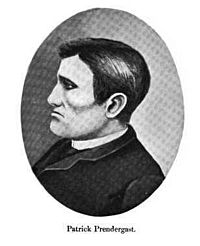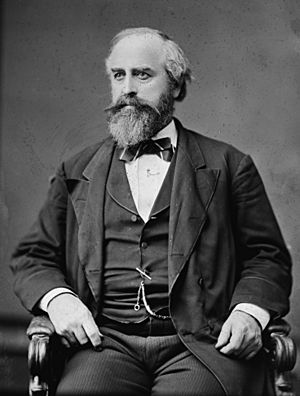Patrick Eugene Prendergast facts for kids
Quick facts for kids
Patrick Eugene Joseph Prendergast
|
|
|---|---|
 |
|
| Born | April 6, 1868 |
| Died | July 13, 1894 (aged 26) Cook County Jail, Chicago, Illinois, United States
|
| Cause of death | Execution by hanging |
| Occupation | Newspaper distributor |
| Political party | Democratic |
| Criminal status | Executed |
| Conviction(s) | Murder |
| Criminal penalty | Death |
Patrick Eugene Joseph Prendergast (born April 6, 1868 – died July 13, 1894) was an American newspaper distributor who was born in Ireland. He is known for killing Chicago Mayor Carter Harrison, Sr. by shooting him on October 28, 1893. After two trials, where his lawyers tried to argue he was not guilty because of mental illness, Prendergast was found guilty. He was sentenced to death and was executed by hanging on July 13, 1894. He was the only client of the famous lawyer Clarence Darrow to receive the death penalty.
Contents
About Patrick Prendergast
His Early Life
Patrick Prendergast was born on April 6, 1868, in a small area called Cloonamore on Inishbofin island, off the coast of Ireland. He was baptized a few days later. His parents, Ellen King and Patrick Prendergast, were both teachers. His grandfather, William Prendergast, was an army veteran who was said to have suffered from mental illness. Patrick's mother often had "hysterics," and his father died from a serious lung illness.
When Patrick was four years old, he had a bad fall and hit his head. He was unconscious for a long time and was sick for weeks afterward. People described him as a strange child. He liked to be alone, was easily annoyed, and had a poor memory. He didn't do well in school.
In 1873, when he was five, Patrick moved to New York with his older brother, William. When he was 16, he left home because he felt like people were unfairly treating him. By the time he was 18, he started having very big, unrealistic ideas about his own abilities. He also became a strong supporter of the "single-tax" idea, which was promoted by Henry George.
Working in Chicago
Prendergast became a newspaper distributor in Chicago. He was very concerned about the safety of railroad crossings in the city. He believed these crossings were dangerous for people and pushed for them to be improved.
In 1893, he supported Carter Harrison's campaign to be re-elected as mayor. Prendergast believed that if Harrison won, he would be given an important job as a city lawyer. Harrison was elected mayor in April 1893 for his fifth term. Before and after the election, Prendergast wrote many letters and visited the offices of politicians who worked with Harrison. He was still convinced he would get the job.
The Mayor's Death
When Prendergast didn't get the job he expected, he went to Mayor Harrison's home on October 28, 1893. He rang the doorbell at 7:50 p.m. A maid let him in and went to wake the mayor, who was resting. As Mayor Harrison came into the hallway, Prendergast shot him three times with a .38 revolver. The mayor was hit in his stomach, under his left arm (which hit his heart), and in his left hand.
The mayor's driver heard the shots and ran towards the sound with his own pistol. He fired three times at Prendergast, who was trying to escape, but didn't hit him. Prendergast also fired back. Mayor Harrison was seriously injured and died in his home at 8:25 p.m.
Several people and a police officer chased Prendergast down Ashland Avenue. He ran to the Des Plaines Street police station and immediately gave himself up. He still had the gun with him. When the police questioned him, he gave different reasons for his actions. He mentioned not getting the job and the mayor not fixing the train tracks. The smell of gun smoke and the empty bullet spots in the gun showed the police that Prendergast was telling the truth.
Prendergast was then taken to the Central Station downtown. A crowd of 5,000 people quickly gathered around the building. The police worried about the crowd becoming violent. So, at 11:15 p.m., Prendergast was secretly put into a wagon and taken to another police station on the North Side of the city. He was then put in the county jail to wait for his trial.
His Trials
In his first trial, Prendergast's lawyer tried to argue that he was not mentally well enough to be responsible for his actions. This is called an insanity defense. However, other lawyers in Chicago disagreed. They pointed out that Prendergast had carefully kept an empty spot in his revolver where the hammer would rest. This showed he was thinking clearly because carrying an old revolver with a bullet under the hammer could make it fire if dropped. Modern revolvers have safety features to prevent this.
Several doctors said that even though Prendergast had strange ideas, he knew the difference between right and wrong. They believed he was able to stand trial for the murder. Later, Clarence Darrow helped Prendergast get another hearing about his mental state. But this defense also failed in the second trial, and Prendergast was found guilty. He was sentenced to death.
The Execution
On the morning of July 13, 1894, at 10 a.m., Sheriff James H. Gilbert visited Prendergast's cell in Cook County Jail. He read Prendergast the official order for his execution. Prendergast's brother, John, visited him one last time at 11 a.m. By this time, there was no longer any hope that the governor would stop the execution. A doctor visited him at 11:30, and he spent a short time with a priest. He told the priest that he had not meant any harm when he killed Mayor Harrison. Five minutes before his scheduled execution at 11:45, Prendergast's lawyer, S.S. Gregory, arrived. He was allowed to shake Prendergast's hand and say a few words.
A gallows (a structure used for hanging) had been built in the jail's north hallway. Seats were set up for about 500 witnesses, including the jury members who had found him guilty. At 11:43, Prendergast was led to the gallows. Father Gilbert from the Cathedral of the Holy Name was with him to perform the last rites of the Catholic Church.
Prendergast walked to the edge of the trapdoor by himself, where his hands were tied. He had planned to make a final statement, but the priest had convinced him not to. He quietly told the priest his last words: "I had no malice against anyone." Prendergast's feet, knees, and chest were tied with straps. A white cloth was placed over him, and he was moved onto the trapdoor. The rope was put around his neck, and a white cloth hood was placed over his head and the rope, so they couldn't be seen.
A signal was given, and at 11:48, the rope holding the trapdoor was cut. Prendergast's neck was broken by the six-foot fall, and his body did not move. His heart continued to beat for about ten minutes before stopping. Five minutes later, his body was taken down and placed in a coffin for burial.
Prendergast in Media
Patrick Prendergast's story has appeared in movies and books. In the 1991 TV movie Darrow, he was played by actor Paul Klementowicz. Prendergast's story is also a part of Erik Larson's popular 2003 non-fiction book, The Devil in the White City.
See also
- The Devil in the White City
- Charles Guiteau, who killed President James Garfield and had similar reasons



